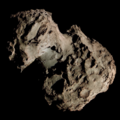An editor has nominated this article for deletion. You are welcome to participate in the deletion discussion , which will decide whether or not to retain it. |
The topic of this article may not meet Wikipedia's notability guideline for astronomical objects .(December 2024) |
| Discovery | |
|---|---|
| Discovered by | Jacqueline B. Fazekas |
| Discovery site | Mount Lemmon Obs. |
| Discovery date | 11 December 2024 |
| Designations | |
| CK24X010 | |
| Orbital characteristics [1] | |
| Epoch | 15 December 2024 (JD 2460659.5) |
| Observation arc | 8 days |
| Number of observations | 41 |
| Aphelion | 15.30 AU |
| Perihelion | 3.814 AU |
| Semi-major axis | 9.557 AU |
| Eccentricity | 0.60096 |
| Orbital period | 29.54 years |
| Inclination | 6.450° |
| 352.513° | |
| Argument of periapsis | 123.442° |
| Longitude of perihelion | 296.087° |
| Next perihelion | 30 July 2025 |
| TJupiter | 2.697 |
| Earth MOID | 2.835 AU |
| Jupiter MOID | 0.354 |
| Comet total magnitude (M1) | 11.2 |
C/2024 X1 (Fazekas) is a Jupiter-family comet. It was discovered by Mt. Lemmon Survey scientist, J. B. Fazekas. [2]

